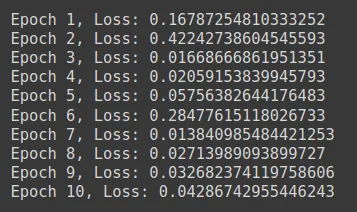Many methods have been proven effective in improving model quality, efficiency, and resource consumption in Deep Learning. The distinction between fine-tuning vs full training vs training from scratch can help you decide which approach is right for your project. Then, we will review them individually and see where and when to use them, using code snippets to illustrate their advantages and disadvantages.
Learning Objectives:
It means building and training a new model on the fly using your dataset. Starting with random initial weights and continuing the whole training process.
Here’s an example using PyTorch to train a simple neural network from scratch:
import torch
import torch.nn as nn
import torch.optim as optim
from torchvision import datasets, transforms
# Define a simple neural network
class SimpleNN(nn.Module):
def __init__(self):
super(SimpleNN, self).__init__()
self.fc1 = nn.Linear(28*28, 128)
self.fc2 = nn.Linear(128, 64)
self.fc3 = nn.Linear(64, 10)
def forward(self, x):
x = torch.flatten(x, 1)
x = torch.relu(self.fc1(x))
x = torch.relu(self.fc2(x))
x = self.fc3(x)
return x
# Load the dataset
transform = transforms.Compose([transforms.ToTensor(), transforms.Normalize((0.5,), (0.5,))])
train_dataset = datasets.MNIST(root='./data', train=True, download=True, transform=transform)
train_loader = torch.utils.data.DataLoader(train_dataset, batch_size=64, shuffle=True)
# Initialize the model, loss function, and optimizer
model = SimpleNN()
criterion = nn.CrossEntropyLoss()
optimizer = optim.Adam(model.parameters(), lr=0.001)
# Training loop
for epoch in range(10):
for images, labels in train_loader:
optimizer.zero_grad()
output = model(images)
loss = criterion(output, labels)
loss.backward()
optimizer.step()
print(f"Epoch {epoch+1}, Loss: {loss.item()}")

Full training typically refers to training a model from scratch but on a large and well-established dataset. This approach is common for developing foundational models like VGG, ResNet, or GPT.
Here’s an example using TensorFlow to train a CNN on the CIFAR-10 dataset:
import tensorflow as tf
from tensorflow.keras import datasets, layers, models
# Load the CIFAR-10 dataset
(train_images, train_labels), (test_images, test_labels) = datasets.cifar10.load_data()
# Normalize the images
train_images, test_images = train_images / 255.0, test_images / 255.0
# Define a CNN model
model = models.Sequential([
layers.Conv2D(32, (3, 3), activation='relu', input_shape=(32, 32, 3)),
layers.MaxPooling2D((2, 2)),
layers.Conv2D(64, (3, 3), activation='relu'),
layers.MaxPooling2D((2, 2)),
layers.Conv2D(64, (3, 3), activation='relu'),
layers.Flatten(),
layers.Dense(64, activation='relu'),
layers.Dense(10)
])
# Compile the model
model.compile(optimizer='adam',
loss=tf.keras.losses.SparseCategoricalCrossentropy(from_logits=True),
metrics=['accuracy'])
# Train the model
history = model.fit(train_images, train_labels, epochs=10,
validation_data=(test_images, test_labels))

Utilizing a pre-trained model and making minor modifications to make it suitable for a particular task. You generally freeze the first few layers and train the rest on your dataset.
Here’s an example using Keras to fine-tune a pre-trained VGG16 model on a custom dataset:
import tensorflow as tf
from tensorflow.keras.applications import VGG16
from tensorflow.keras import layers, models
from tensorflow.keras.preprocessing.image import ImageDataGenerator
# Load the pre-trained VGG16 model and freeze its layers
base_model = VGG16(weights='imagenet', include_top=False, input_shape=(150, 150, 3))
for layer in base_model.layers:
layer.trainable = False
# Add custom layers on top of the base model
model = models.Sequential([
base_model,
layers.Flatten(),
layers.Dense(256, activation='relu'),
layers.Dense(1, activation='sigmoid')
])
# Compile the model
model.compile(optimizer='adam', loss='binary_crossentropy', metrics=['accuracy'])
# Load and preprocess the dataset
train_datagen = ImageDataGenerator(rescale=0.5)
train_generator = train_datagen.flow_from_directory(
'path_to_train_data',
target_size=(150, 150),
batch_size=20,
class_mode='binary'
)
# Fine-tune the model
history = model.fit(train_generator, epochs=10, steps_per_epoch=100)
| Aspect | Training from Scratch | Full Training | Fine-Tuning |
| Definition | Building and training a new model from random initial weights. | Training a model from scratch on a large, established dataset. | Adapting a pre-trained model to a specific task by training some layers. |
| Use Cases | Unique data, novel architectures, research & development. | Foundational models, benchmarking, industry applications. | Transfer learning, domain adaptation, limited data or resources. |
| Advantages | Full control, custom solutions for specific needs. | High performance, establishes benchmarks, robust and generalized models. | Efficient, less resource-intensive, good performance with little data. |
| Disadvantages | Highly resource-demanding requires extensive computational power and expertise. | Less flexibility and risk of overfitting with small datasets. | High performance establishes benchmarks and robust and generalized models. |
Considering these factors, you can determine your deep learning project’s most appropriate training method.
Your specific case, data availability, computer resources, and target performance influence whether to fine-tune, fully train or train from scratch. Training from scratch is flexible but requires substantial resources and large datasets. Full training on established datasets is good for developing basic models and benchmarking. Fine-tuning efficiently uses pre-trained models and adjusts them for particular tasks with limited data.
Knowing these differences, you can choose the suitable approach for your machine learning project that maximizes performance and resource utilization. Whether you are constructing a new model, comparing architectures, or modifying existing ones, the right training strategy will be fundamental to achieving your ambitions in machine learning.
A. Fine-tuning involves using a pre-trained model and slightly adjusting it to a specific task. Full training refers to building a model from scratch using a large, well-established dataset. Training from scratch means building and training a new model entirely on your dataset, starting with randomly initialized weights.
A. Training from scratch is ideal when you have a unique dataset significantly different from any existing dataset, are developing new model architectures or experimenting with novel techniques, or are conducting academic research or working on cutting-edge applications where existing models are insufficient.
A. The advantages are complete control over the model architecture and training process, allowing you to tailor them to your data’s specific characteristics. It is suitable for highly specialized tasks where pre-trained models are unavailable.
A. Full training involves a model from scratch using a large and well-established dataset. It is typically used to develop foundational models like VGG, ResNet, or GPT, benchmark different architectures or techniques, and create robust and generalized industrial models.
Lorem ipsum dolor sit amet, consectetur adipiscing elit,